Sunday, July 25, 2010

Painting is a practice undertaken by a person to express his/her feelings, emotions etc on a surface.
The various surfaces that can be used are paper, canvas, glass and so on and so forth. A painting is very different from a 3D version.
It can be rightly said that color to a painting is what sound is to music. An collection of paintings consists of landscapes, portraits, theoretical figures and many more.
Museums are the ideal place for a person to view the works of great painters ranging from the Early Renaissance Period to today’s skilled artists.
People undertake painting as a hobby or even as a form of income.
For some people, painting is a form of tension release.
The feeling of applying color to a surface gives a person a kind of high that cannot be experienced from any other form of art.
Some of the paintings are closely touch to the heart. The author expose the feelings in his paintings very genuinely.
Thursday, July 15, 2010

Landscape art is a term that covers the depiction of natural scenery such as mountains, valleys, trees, rivers, and forests, and especially art where the main subject is a wide view, with its elements arranged into a coherent composition.
In other works landscape backgrounds for figures can still form an important part of the work.
Sky is almost always included in the view, and weather is often an element of the composition.
Detailed landscapes as a distinct subject are not found in all artistic traditions, and develop when there is already a sophisticated tradition of representing other subjects
Landscape backgrounds for various types of painting became increasingly prominent and skilful during the century.
The period around the end of the 15th century saw pure landscape drawings and watercolours from Leonardo da Vinci, Albrecht Dürer, Fra Bartolomeo and others.
But pure landscape subjects in painting and printmaking, still small, were first produced by Albrecht Altdorfer and others of the German Danube School in the early 16th century.
At the same time Joachim Patinir in the Netherlands developed a style of panoramic landscapes with a high aerial viewpoint that remained influential for a century, being used, for example, by Pieter Brueghel the Elder.
The Italian development of a thorough system of graphical perspective was now known all over Europe, which allowed large and complex views to be painted very effectively
Friday, July 9, 2010

Victorian artists initially took their cute paintings from Shakespeare but soon devised their own scenarios.
By the mid 1800's a tradition developed among British and Scottish Painters that continues today the world over in every known media.
This exhibition of contemporary fairy Paintings, drawings and pictures embraces this tradition.
Faeries: also Fairy or Fairy, have long been the common terms for a legendary race of clever super- natural beings who meddle in human affairs, but they are known by many names.
Commonly associated with the Celts, Fairies are not the product of one culture or time; they have a pedigree.
Ancient Greek Heroes had fairy lemans, called nymphs, and the faraway Asians, Eskimos and American Indians had similar fairy legends as well.
The mythic Gandharvas of Sanskrit poetry were also fairies.
Many fairy tales popular today had their origins in the folk tales of prehistoric times...
Tuesday, July 6, 2010
 Mona Lisa (also known as La Gioconda or La Joconde) is a sixteenth-century portrait painted in oil on a poplar panel in Florence, Italy by Leonardo di ser Piero da Vinci during the Renaissance.
Mona Lisa (also known as La Gioconda or La Joconde) is a sixteenth-century portrait painted in oil on a poplar panel in Florence, Italy by Leonardo di ser Piero da Vinci during the Renaissance.The work is currently owned by the Government of France and is on display at the Louvre museum in Paris under the title Portrait of Lisa Gherardini, wife of Francesco del Giocondo questionably, it is the most famous and iconic painting in the world.
The painting is a half-length portrait and depicts a woman whose facial expression is frequently described as unknowable there believe that the slight smile is an indication that the subject is hiding a secret.
The ambiguity of the subject's expression, the monumentality of the composition, and the slight modeling of forms and atmospheric illusionism were novel qualities that have contributed to the continuing fascination and study of the work.
In 1911, it was stolen and derivative; the copies were sold as the genuine painting. It was recovered in 1913.
Saturday, July 3, 2010
 Painting on glass is a remarkable art form and requires you to learn some really meticulous glass painting techniques. The beauty of these paintings leaves one amazed as both the medium and the painting combine to give an ethereal effect.
Painting on glass is a remarkable art form and requires you to learn some really meticulous glass painting techniques. The beauty of these paintings leaves one amazed as both the medium and the painting combine to give an ethereal effect.- Sketch the designs at the back of the sheet of the glass.
- After outlining the design apply colors using a brush or directly with hand, making sure that they do not spill over.
- Use only gum-based colors, they are more durable.
- Make sure the part you have just painted is dry before moving on to the next section.
- Fire the paints onto the glass using a kiln if you want the paint to be permanent.
- Voila you have a wonderful glass painting ready to be displayed.
Tajmahal Paintings
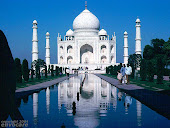
Painting Iteams
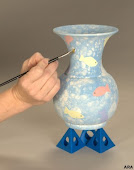
Creation of Paintings

Painting Equipments

Beautiful Rose Painting
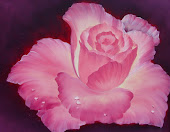
Green Nature Painting
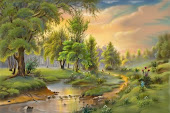
Canvas Painting

Pictute of Artist

Color Paintings
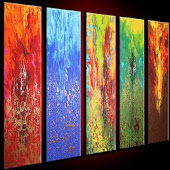
Online Paintings
